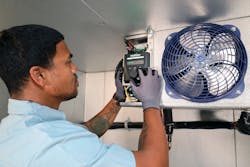When it comes to walk-in coolers and freezers, selecting the right equipment size is crucial for optimal performance and energy efficiency. Oversized or undersized equipment can lead to excessive energy consumption, inconsistent temperature control and premature equipment failure.
This article will focus on the key factors to consider when sizing equipment for a walk-in cooler or freezer, using a practical example for load calculation. First, let’s take a look at the key factors you must consider.
Ambient Conditions: Begin by determining whether the walk-in box is located indoors or outdoors, as this affects the ambient temperature surrounding the box. Indoor and outdoor environments have different heat transfer characteristics that influence equipment selection.
Box Temperature and Humidity Requirements: Identify the desired temperature and humidity levels within the walk-in box. This information will determine the type of evaporator coil and condensing unit suitable for the application.
Infiltration Load: Assess the average, heavy or extra heavy usage of the walk-in box to determine the infiltration load. Infiltration refers to the heat, both sensible and latent, that enters the box through door openings. The frequency and duration of door openings impact the cooling load.
Product Load: Take into account the type of products stored in the walk-in box, their weight, the initial temperature upon entry and the desired pulldown time. These factors help calculate the cooling load required to bring the products to the desired temperature.
Miscellaneous Loads: Consider other factors that contribute to the overall cooling load, such as lighting (1 watt/square foot), motors (based on the volume of the box), forklifts, people and glass doors. These additional loads influence the equipment sizing requirements.
Electrical Service: Determine the available electrical service in terms of voltage and phase. This information ensures the proper selection of equipment compatible with the electrical supply.
Condensing Unit and Evaporator Type: Decide whether the condensing unit(s) will be installed indoors or outdoors and whether air-cooled or water-cooled units are preferred. Select the appropriate evaporator type, such as heavy-duty, low silhouette or low velocity, based on the specific cooling requirements.
Load Calculation Example
Let's use an example to illustrate the load calculation process. Suppose we have a cooler with the following specifications:
- Room temperature: +35°F (+95°F ambient)
- Box dimensions: 30' x 50' x 10' with 4" styrene insulation in walls and ceiling
- Product: 10,000 lbs. entering at 90°F, with a pulldown time of 12 hours to reach 40°F
Based on these parameters, the load calculation is as follows:
- Box Load: 30' x 50' = 1,500 sq. ft. (box area)
- Box Load = 1,500 sq. ft. x 62.8 MBH + 10% (safety margin) = 66,600 BTUH
- Product Load: 10,000 lbs. x 666 BTUH to cool 1,000 lbs. per day / 10°F temperature difference = 66.6 MBH
- Total Load: 66.6 MBH (product load) + 62.8 MBH (box load) + 10% = 135,560 BTUH
Accurate Load Calculations in the Field
Contractors and technicians in the field can streamline the process of sizing equipment for walk-in coolers and freezers by leveraging innovative tools such as the Refrigeration Toolkit Mobile App by Heatcraft Refrigeration Products. This app offers a comprehensive set of tools and resources that enable contractors and technicians to determine the necessary specifications quickly and accurately for walk-in cooler and freezer installations. Let's explore some of the key features of this app:
Box Load Calculator: The app enables a quick and easy way to obtain load calculation within seconds by selecting a box size and room temperature on either a typical or heavy load condition. The app does all the calculations internally and allows the user to pick the right walk-in cooler or freezer application using the quick selection tools.
Quick Selection Tools: The app comes pre-loaded with a vast product database that contains information about various evaporator coils and condensing units for walk-in cooler or freezer applications. Contractors and technicians can easily access this database to select the appropriate equipment based on the specific requirements of the project. This eliminates the need for manual reference books or additional research, saving valuable time and effort. Once the load calculation is done the app recommends condensing units and evaporator coils (unit coolers).
Energy Calculator: The app provides the functionality to determine if it is beneficial to upgrade the existing system, resulting in energy cost savings and improved compliance. It allows for easy selection of equipment and provides an estimation of potential savings achieved through upgrading to a newer system. Many older systems are inefficient and consume excessive energy, and the app enables users to calculate the return on investment (ROI) for upgrading.
Built-in Formulas and Calculators: The app includes a comprehensive library of formulas and calculators that facilitate quick calculations.
Conclusion
Accurate equipment sizing is essential for maintaining optimal performance and energy efficiency for walk-in coolers and freezers. By carefully considering factors such as ambient conditions, box dimensions, insulation, product loads and miscellaneous loads, contractors can ensure that the selected equipment meets the specific requirements of the application.
In addition, the utilization of advanced tools such as the Refrigeration Toolkit Mobile App by Heatcraft Refrigeration Products can significantly streamline the equipment sizing process.
Properly sized equipment not only ensures consistent temperature control but also minimizes energy consumption and prevents premature equipment failure. By considering the unique characteristics of each project, contractors can select the appropriate evaporator coils, condensing units and other components to efficiently meet the cooling demands.
Ultimately, accurate equipment sizing is a critical step in providing reliable and efficient cooling solutions for walk-in cooler and freezer applications. By considering all the necessary factors and utilizing the available resources and tools, contractors can deliver optimal results that meet the specific needs of their clients.











